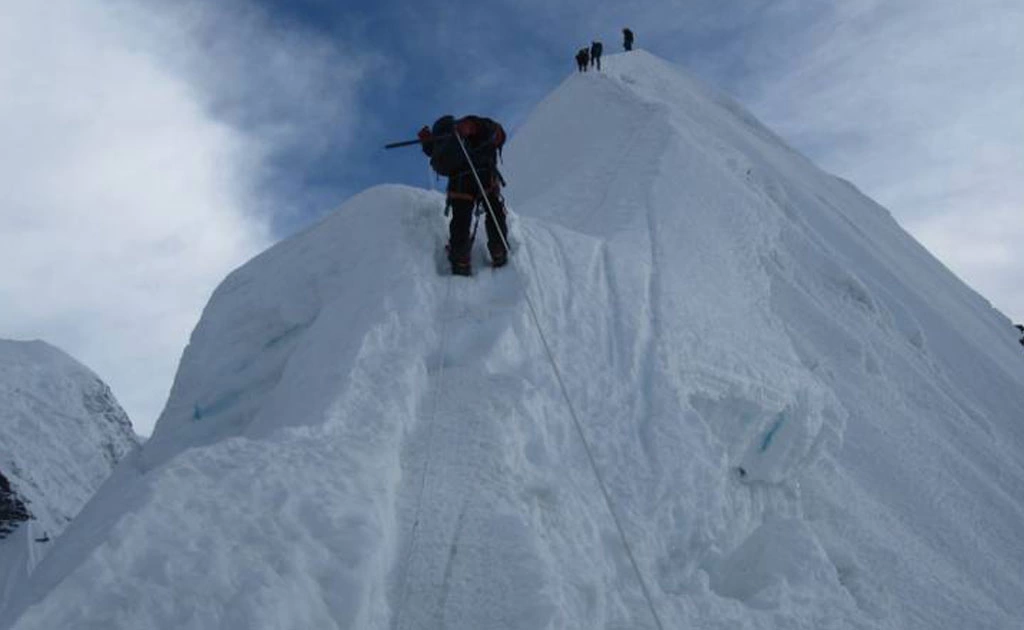Island Peak Climbing, 21 Days Cost for 2025 and 2026
Island peak climbing is a 21 days adventurous trip in Nepal that explores the historical sites in Kathmandu and takes you to the Khumbu region, the eastern Himalayas. The island peak is a trekking peak, which means a perfect 6,000 meters to climb. Both beginners and experienced climbers can participate in our Island peak climbing 2025 departure. In the Nepali tongue, the Island peak is known as Imja Tse.
If you have been trekking in the Himalayas and covered some major routes and now looking to upgrade your level, then Island peak climbing in Nepal is one of the best options. The technical difficulty on Island Peak is a few to none, so you can join this climbing expedition without previous mountaineering experience. Standing at 6,189 meters, Island Peak is a stunning mountain to climb as your first peak climbing in Nepal.
Island Peak Climbing with a Trek to Kala Patthar
Our Island peak climbing itinerary combines a trek to Kala Patthar that will let you acclimatize before pushing towards the Island peak base camp. If you want, you can extend the itinerary to the Everest base camp too. The trekking part is very immersive and exciting as you will be spending nights in beautiful Sherpa villages, walking through lush rhododendron forests, visiting ancient monasteries, and witnessing surreal landscapes.
The trek begins from Lukla village, and you will descend to Phakding, following the Dudh Koshi river. From here, the trail ascends to Namche Bazaar, crossing numerous suspension bridges on the Dudh Koshi river and passing by densely forested paths. We have an acclimatization break in Namche Bazaar and go on a hike to Hotel Everest View. The trail then goes to Tengboche village via Phunki Tenga, and we take a different route to Pheriche.
Following a steep track, you will trek along the Khumbu glacier moraine to Lobuche village. Next day, hike to Kala Patthar and back to Lobuche. We descend to Dingboche village and then continue to Chhukung valley. From Chhukung village, we head to Island Peak base camp, and our climbing journey begins.
Climbing Training at the Base Camp
Our supporting crew will prepare the base camp in advance to welcome you. Upon reaching the Island peak base camp, get freshen up and have a warm meal. We will rest, and later in the day, our guide will give you basic pre-climbing training. This training will teach you how to navigate the mountain and follow the instructions of the guides. You learn to use climbing gear and discuss all the possibilities above base camp.
Likewise, we will check the climbing boots with crampons and practice walking. We have to be well-rested to push to Island peak high camp, and above that, therefore we will end the day early.
Summit Day at Island Peak
On the summit day, you will begin climbing toward the summit at dawn. Above the high camp, ascend following a rock ridge to a glacier. The track then steeply ascends to a snow headwall. The guide will fix the ropes. You will climb a 60 - 70 degree face about 150 meters to the summit ridge. From the summit, the views of the mountains like Everest, Lhotse, Nuptse, Kanchenjunga, and Cho Oyu are phenomenal.
What is so Special About Climbing Island Peak?
Climbing Island Peak offers a unique and challenging experience for climbers, as it combines elements of high-altitude trekking and climbing.
Some of the reasons that make Island Peak special include:
Location: Island Peak is located in the heart of the Himalayas in Nepal, offering climbers stunning views of some of the world's highest mountains, such as Mount Everest, Lhotse, and Ama Dablam.
Technical Difficulty: While Island Peak is considered less technical than some of the other peaks in the Himalayas, it still requires a certain level of climbing experience and fitness. The ascent to the summit involves steep and challenging terrain, such as rock, ice, and snow. A perfect climbing introduction for rookie climbers.
Altitude: At 6,189 meters (20,305 feet) above sea level, Island Peak offers climbers the opportunity to experience the thin air and reduced oxygen levels of high-altitude climbing.
Acclimatization: Climbing Island Peak is a great way to acclimatize or test the water before attempting to climb higher peaks in the Himalayas, such as Mount Everest.
Cultural Experience: The climb to Island Peak also offers the opportunity to experience the culture and lifestyle of the Sherpa people, who have lived in the region for centuries and have a deep knowledge of the mountains.
Scenery: Island peak is located in the Sagarmatha National Park, which is a UNESCO World Heritage Site, and offers trekkers and climbers a chance to experience the diverse flora and fauna, as well as the panoramic views of the highest mountain ranges in the world.
Optional Climbing Packages
You can join our Island peak climbing in Nepal or check out these other famous trekking peaks for more options- Mera peak climbing, Tharpu Chuli peak climbing, Pisang peak climbing, and Chulu west peak climbing.

